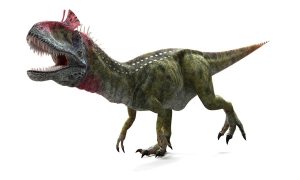
28 interesting facts about Giganotosaurus
- 👁️ 465
Giganotosaurus, a name that evokes images of immense size and fearsome power, roamed the lands of what is now South America during the Late Cretaceous period, approximately 98 million years ago. This colossal predator, whose name means “giant southern lizard,” is one of the largest meat-eating dinosaurs ever discovered. With its massive size, sharp teeth, and powerful legs, Giganotosaurus was a formidable hunter, capable of taking down even the largest of prey. Its discovery has challenged previous notions about the size and dominance of theropod dinosaurs, providing invaluable insights into the prehistoric world. Here are 28 interesting and informative facts about Giganotosaurus that highlight its characteristics, discovery, and place in the dinosaur world.
- Giganotosaurus carolinii is the only recognized species of this genus.
- It was discovered in 1993 by Rubén Carolini, an amateur fossil hunter, in Patagonia, Argentina.
- Giganotosaurus is estimated to have been up to 12 to 13 meters (39 to 43 feet) long.
- It likely weighed between 6 to 13.8 metric tons, making it one of the largest theropods.
- The skull of Giganotosaurus was over 1.8 meters (6 feet) in length.
- Unlike Tyrannosaurus rex, Giganotosaurus had longer arms with sharp claws.
- Its teeth were serrated, designed for slicing flesh rather than crushing bones.
- Giganotosaurus lived in a region that was a mix of forest and plain, alongside large herbivorous dinosaurs like Argentinosaurus.
- This dinosaur is believed to have been a predator or scavenger, possibly hunting in groups.
- The holotype specimen of Giganotosaurus was nearly 70% complete when discovered.
- Its brain was relatively small compared to its body size, similar to other large theropods.
- Giganotosaurus had a narrow, pointed tail, which may have been used for balance and swift turns.
- The discovery of Giganotosaurus challenged the notion that T. rex was the largest carnivorous dinosaur.
- Fossil evidence suggests Giganotosaurus had a fast growth rate.
- It belonged to the Carcharodontosauridae family, known for their sharp teeth and large size.
- The environment of Giganotosaurus included rivers and lakes, supporting a diverse ecosystem.
- Giganotosaurus’ prey likely included giant sauropods and ornithopods.
- The dinosaur’s jaw had a powerful bite force, but not as strong as that of T. rex.
- Studies suggest Giganotosaurus had good vision, aiding in hunting and navigation.
- The dinosaur’s fossils are displayed in several museums, including the Carmen Funes Museum in Argentina.
- Giganotosaurus’ habitat was shared with other large carnivores, indicating complex predator-prey dynamics.
- Its name is often mispronounced; the correct pronunciation is “Ghee-gah-noh-toe-saw-rus.”
- Giganotosaurus may have had a rivalry with the similarly sized Mapusaurus, based on fossil evidence from the same region.
- Unlike many popular portrayals, there is no evidence to suggest Giganotosaurus had feathers.
- The gap between its front teeth and the rest of the dentition may have helped it better grip prey.
- Giganotosaurus is considered one of the apex predators of its time and region.
- Reconstruction of its locomotion suggests it could run at speeds up to 31 mph (50 km/h).
- The discovery of Giganotosaurus has sparked interest in the diversity of Cretaceous South American dinosaurs.
Giganotosaurus stands as a monumental discovery in the field of paleontology, reshaping our understanding of dinosaur ecology and evolution. Its immense size and predatory lifestyle offer a glimpse into the dynamic and competitive world of the Late Cretaceous period. As research continues, Giganotosaurus will undoubtedly remain a subject of fascination and study, symbolizing the incredible diversity and complexity of prehistoric life on Earth. This giant southern lizard not only challenges the supremacy of the more famous T. rex but also highlights the rich dinosaur fauna of ancient South America, inviting further exploration and discovery.











